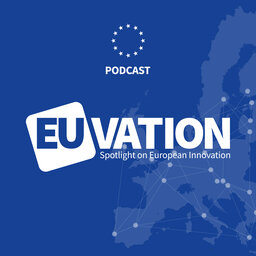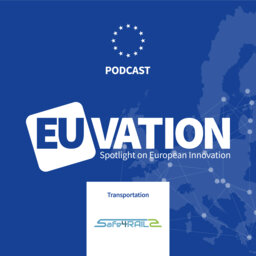Safe4RAIL-2 (4) H2020 Project: Focus on Work Package 3
In this episode, we discus work package 3 (Functional Distribution Framework and Simulation Framework) in the Safe4RAIL-2 project. This work package is dedicated to technological developments producing dedicated project outcomes such as deliverables and implementations.
Iñigo Odriozola is the work package lead and he joins us to talk about the project's benefits to the general public.
This project has received funding from the European Union’s Horizon 2020 research and innovation programme under grant agreement No. 826073. The information and views set out in this document are those of the author(s) and do not necessarily reflect the official opinion of Shift2Rail Joint Undertaking. The JU does not guarantee the accuracy of the data included in this article. Neither the JU nor any person acting on the JU’s behalf may be held responsible for the use which may be made of the information contained therein.
Powerful collaborations, cutting edge science and curious minds coming together for a glimpse of the future. Stay tuned as we look at the latest updates on some of the most promising technology projects.
Hello and welcome, I'm your host, Peter Balint from Technikon. Today, we look again at the SafeRAIL-2 project. The overall goal in SafeRAIL-2 is to improve the efficiency and reliability of the railway system in Europe. To that end, there is quite a bit of work dedicated to unifying train subsystem providers. Part of this work is achieved under Work Package three, which is dedicated to technological developments producing dedicated project outcomes such as deliverables and implementations. Iñigo Odriozola is the lead of Work Package three, and he joins us today to talk about it. Welcome and thanks for coming on.
Good afternoon. Thank you for inviting me to this talk.
A quick look at the project website tells us that work package three is entitled Functional Distribution Framework and Simulation Framework. Can you simply explain these two areas, especially in the context of how they may affect the average European train riding citizen?
Sure, sure. So on the one hand, we've got the functional distribution framework, what we call the FDF. So the FDF is a generic framework which can host different train functions, different applications on the same device, on the same control unit. And this could allow us to avoid having dedicated equipment for each train function, each with its particularities, its complexity and so on. So how is this achieved? So the FDF offers a common set of services and abstraction from the underlying device. This means operating system and specific hardware, dedicated actuators below and so on. So, for example, a train has among many others 2 functionalities, for instance, one door control unit and one HVAC. H-V-A-C, which means heating, ventilation and air conditioning unit functionality. So nowadays these would be two different dedicated devices. OK, so by the use of the FDF, two applications, holding the logic of the of the function would be running on a single device. So this means every time there is an update, an upgrade, anything to be changed, there's no need to change the whole equipment with its cabling and so on. But just the application. So therefore the the number and the complexity of the equipment in our train is reduced considerably by the use of this solution. OK. Another important feature is the interoperability, the abstraction from the device below allows the portability of applications between different sort of devices. So, for instance, with the aforementioned example, a total control application can run all the same in a control unit, in a train by a German vendor or that of a French vendor. On the other hand, the simulation framework, or SF, as we call it, is a set of tools for train virtualization and simulation. OK, so this means basically you can connect a train by Spanish vendor and a door control unit by an Italian provider without the need of being actually at the same place. This will make it easier to test that both parts interact with each other correctly, and if you allow me, there is a third concept which plays an important role, which is in fact a key element towards the success of the the solutions that we are proposing. And those are on this concept is The application profiles OK, teh application profiles determine how the TCMS, which is the brain of the train on different subsystems, talk to each other. OK, so again, following with the example subsystem provider would use the function 'activate door' a function or call to activate the door, but another one may use of 'door on' function to to just activate it. So with the application profiles, we would have a generic, standardised dictionary of those functions. And those calls, those messages that are shared between the brain of the train (TCMS) and the different subsystems. So coming back to your question in such a context, by bringing these solutions to the market, we could contribute to increase the price competition among manufacturers and subsystem suppliers, which will have an impact on the money that train operators will have to spend on the trains. And definitely in the end, this would translate into lower end prices for customers, for the travelers. Additionally to that, there is a shorter time for the train to be brought back into service after any change update upgrade issue has been found that needs to be changed since the complexity of the equipment is reduced. So to sum up, the train riding in citizens will feel this change in their pockets in the travel experience.
And so this is very interesting. It sounds like you're not only unifying the functions on a train, but you are also unifying the suppliers that make equipment for the trains, because now they all maybe speak one common language. So you don't have a situation where they're doing one thing in Italy and another thing in Germany.
Yeah. So indeed, this is one of the key objectives of Safe4RAIL project on the whole and also of work package 3. So we want to achieve the interoperability of different original equipment manufacturers. And to allow that an application can run in different solutions, which may even be proprietary, the providers will have for sure a different solution of the different, however different kind of operating system running in the in the equipment. So this is up to each of the original equipment manufacturers. They can prefer to make use of of a given equipment that given operating system. But they will all have to provide generic set of services by the use of the FDF.
OK, and I want to sort of go back to something you mentioned earlier, drill down a little bit further. And this is about the simulation framework. I've done some reading and it appears that with the simulation framework, the real benefit here is when it comes to testing results or testing the work that you have done. Could you tell us about that a little bit?
Yes, sure, so I can speak of the experience that we had in the project, so on the one hand we would have for instance, the HVAC application running on a controlled unit located at the CAF premises in Beasain, Spain on the other side would have a physical HVAC unit, physical HVAC equipment, providing the heating, ventilation and air conditioning functions in a closed chamber. And this would be located at Korneuburg in Austria. OK, by the use of the simulation framework, we were able to connect both elements together. Well, through our camera, I could see with my own eyes how by the use of the simulation framework we could make a wide range of different tests -we could actually actuate on the cooling system located in Austria after commanding it so from Beasain CAF premises, as if they were sitting side by side. OK. With the simulation framework as well, for the cases in which, for instance, this chamber, this climate chamber in which we have the physical HVAC equipment is not available, then we could have an HVAC simulation model replacing this HVAC equipment the original equipment. And apart from this, the simulation framework also enables us to simulate the training environment. So this is its interaction with other subsystems. As I mentioned before, there are many subsystems in the train doors, their brake system, so we could simulate all of the subsystems residing in the train environment of the train, the load of the of the train. The passenger occupancy, the position of the sun, even the train driving direction and so on and so on. And all these parameters, all those parameters that would influence the operation of the HVAC unit, all connected by the use of the simulation framework. So as you can see, there's an early validation of the functionality, of the timing, of the reliability of the of the systems as we did in this case, in the case of the HVAC subsystem connected with the air control unit at CAF premises. And without the need to actually travel to the factory in which the train is being produced or is being built, we could already test the control unit and the subsystem were communicating correctly. So it can be clearly seen that the time and the cost reduction you can achieve with this solution is really big.
Yeah, this is huge. I mean, what incredible timesaver as well as our money saver.
Yeah, sure sure. All the testing costs, the integration cost, the certification costs are considerably reduced. And another advantage of this way of being able to test the subsystem remotely is that you can even plan for incremental tests as you go just implementing the application.
So something like the simulation framework, this is all really great and you're doing some really good work with your consortium in Safe4RAIL-2 when is it that we might see these testing scenarios being played out in real life or in industry or in the railway sector here in Europe?
Well, as mentioned in our previous episode by my colleague, Aitor Arriola the coordinator of the project, Safe4RAIL-2 both, Safe4RAIL-2 and the Connecta-2 projects are working in two labratory demonstrators, which have really high technology readiness level. So in the case of the work package three, the main goal is to integrate the HVAC or the H-V-A-C subsystem in both functional distribution framework and simulation framework instantiations of those two demonstrators. OK, so here we would have Liebherr which is an industrial partner based in Korneuburg as I previously mentioned, which is responsible for developing the HVAC subsystem. We also have ETAS, which is German partner, which is bringing the wide experience from the automotive domain automotive solutions. And if we have a look at the partners in Connecta-2 , we've got Siemens and Bombardier, which are well known vendors. We've got CAF, which is a Spanish or original equipment manufacturer located in the Basque Country close to where we are with which we have a close contact and collaborate in several projects. So those demos with those partners which are involved with a set of subsystems, which have been integrated not only HVAC, but also the door control and so on, are operative as we speak. So the applications have been integrated in both FDF and simulation framework of both lab demonstrators. So as you can see, this is not an academic or exploratory work. This is already are really close to the industrial sector work. So you asked when this could be a reality. So then well, I think this could be brought to the market and within the next, let's say, five to seven years.
So that's really right around the corner. And in Safe4RAIL-2 this is part of the original project was to actually show this proof of concept of your work in a physical demonstrator. And it sounds like everything is going as planned. But it's always interesting because there are there's always setbacks or challenges in a project. And I'm curious in Safe4RAIL-2 what kinds of things did you experience that might have slowed you down or caused you to change course in some way?
Well, I can say it has been a thrilling adventure, but to be honest, it has not been a bed of roses, so to say. I can tell you about a couple of challenges or setbacks. One has to do with the specifications of these services, the interface that the functional distribution framework should have. Much of the specification work was already addressed in Safe4RAIL-1 and Connecta-1 projects, but well, as a matter of fact, this common interface. So this set of functions that the FDF should offer or how to address them was not completely agreed upon between the different original equipment manufacturers. And this is because, as you may imagine, they just traditionally or historically made use of different approaches, different way of doing things. So it was a tedious work in whichSafe4RAIL-2 had to support them. We invested much effort in that. But thanks to the partners of the project, which have a quite experience. Another element which had an impact on the original plan of the project is, as you can imagine, the COVID-19 crisis. So we have planned a set of physical workshops, a set of physical sessions for integrating, for instance, the HVAC application on the on the control unit. But this, due to the restrictions at the moment could not be done. But we could still work together. Nevertheless, we learn how to do this remotely by making use of teleconferences, making use of of other solutions to just ease the communication between the different partners. So it was quite a fruitful activity. Well, this project and all the work within revolves around adapting. So that is what we need. OK, I must also say overall, there was an efficient risk management, so there were contingency plans to tackle risks which could be foreseen. And for those which could not be foreseen, we had just close contact, we just sticked together, there was a constant monitoring, synchronization of the activities. We just offered support when necessary to the partner in need. So in the end, despite the difficulties, the consortium has been a compact working team and has had a remarkable latitude. And those setbacks were efficiently sorted out and luckily did not pose a major issues.
So it sounds like even though you were faced with some pretty big challenges, it's the strength of the consortium that really sort of helps pull you through these things.
Yeah, sure. It was needed high implication and the involvement of all the partners, which were really excited, which were really motivated, and their attitude was, as I mentioned,superb.
And finally, if you look forward, how will your work today affect the future of trains? Or to be more specific, how will your efforts advance the railway sector here in Europe?
Well, let's put it this way. By taking advantage of the interoperability that the concept that we propose offer by standardizing those solutions, the outcome would be as follows. We would have different subsystem providers in one car, in the car of a train, managing the air conditioning system. We would have even trains made up of cars taht were produced by different vendors we would have Spanish CAF or German Bombardier all working together. So this would mean in the end, they will be reduced number diversity and complexity of the equipment in a train. These just ensured by the use of theis structural layer, which is the the functional distribution framework. It is also important to stress that we will have safer trains. So in the end we will have common services that will need to be provided and needs that we need to be covered by this set of solutions, regardless of where you are in Europe. And moreover, we would have a better integration certification costs. We would have better response time to issues. As I mentioned, we would have a train after some issue has been encountered, been brought back to operation in a really short time. So definitely we would have an even more appealing a means of transport than it is today.
OK, and the really exciting thing about this is that this is sort of changing the face of the railway here in Europe. I mean, we've been looking at the same technologies for the last, you know, 50 years. And all of a sudden now we have kind of a whole new frontier here with with improving our railway sector in terms of technology and efficiency. So thank you for telling us a little bit about how your work package contributes to the whole project. We really appreciate it.
Thank you for your time. Well, I hope I have triggered even more your curiosity and that of the audience on it has been a pleasure to share this experience with you, Peter. Thank you.
Thank you.
This podcast has been brought to you by Technikon. This project has received funding from the European Union's Horizon 2020 Research and Innovation Programme under grant agreement number 826073. The information and view set out in this programme are those of the authors and do not necessarily reflect the official opinion of the Shift2RAIL Joint Undertaking. The Joint Undertaking does not guarantee the accuracy of the data included in this episode. Neither the Joint Undertaking nor any person acting on the Joint Undertakings behalf may be held responsible for the use which may be made of the information contained herein.
 EUVATION: Spotlight on European Innovation
EUVATION: Spotlight on European Innovation



